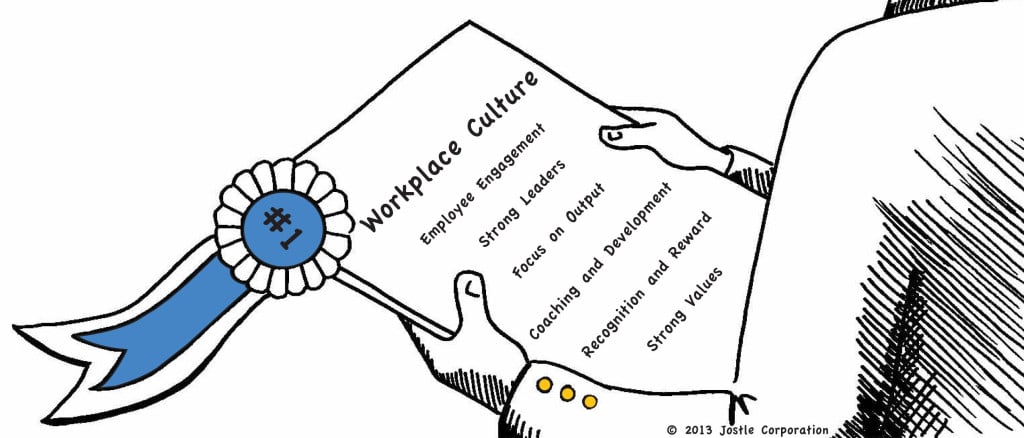When you think of the best places to work, one of the critical factors to consider is that of culture. Culture supports strategy, facilitates change, establishes focus and creates the context for high performance.
I’ve had the luxury to work with some of the best companies in the world and when I have witnessed strong cultures these are the elements I see at play.
- There are high levels of employee engagement. Employees express confidence and a belief that the organization will be successful in achieving its strategic objectives. There is a willingness to “go the extra mile” for the organization, and give the discretionary or extra effort needed to complete priority projects and serve clients. In short, commitment to the organization and its goals are strong, and you can tell by the energy and determination produced by members of your team. High levels of employee engagement have been correlated with greater productivity, revenue growth, customer satisfaction, profitability and even earnings per share.
- Leaders walk their talk, and also talk their walk. The importance of having good role models can’t be understated because they set the pace for work and establish the tone of the organization. We’ve all heard that leaders need to walk their talk, but as exemplars, they need to also talk their walk. That is, they need to promote and advocate the behaviors they model verbally as well, and let people know what is expected of them and the standards everyone will be held to. Then they need to follow suit.
- Coaching and development are the norm. Perhaps the most overused term in business today is that “people are our most important asset.” While it is true, too often it is only given lip service. In cultures where that phrase is not just a platitude, people are routinely given balanced feedback that helps them to perform better. Done well, this comes from their manager as a coach or an independent third party. The only way organizations get better is if their people consistently improve, and the most effective way to do that is by investing time and resources in their growth.
- Focus is on output, not input. The organization is all about results and outcomes, versus strict adherence to process at all costs. That is not to say that there is no process whatsoever; rather, the priority is always what needs to happen, not how it needs to happen. Process or input exists only to create outcomes. In high performance cultures, it is totally acceptable to push back on processes that don’t support an outcome, or worse, hinder an outcome, without being a renegade. This is especially true when it comes to end user or customer focus, where productivity is so vital to success.
- Recognition and reward are in large supply. One of the most frequent complaints of employees who rank low in engagement is they feel underappreciated. A hallmark of a great culture is that it is standard to recognize exceptional performance. Further, recognizing great efforts and improvements in performance are customary as well. This is done best by leaders who are able to highlight the specifics of a job well done, the characteristics of the person who did it and the impact it had on the organization. Having a forum for this kind of recognition is useful, but don’t underestimate the power of impromptu crediting and acknowledgement of good work. When it comes to reward, think both financial and non-financial. High performers, in particular, value the incentives of autonomy, degrees of freedom and stretch assignments that further demonstrate their value.
- Values are visible. The organizations’ values are not simply platitudes that are distributed to employees and hung in frames on the walls. They are observable in the behaviors everyone sees and experiences in their interactions with fellow employees and their managers. Employees will only judge the authenticity of your values by how they feel treated, not by the plaques that espouse them. Getting everyone in an organization to behave in accordance with your values so they are noticeable through interactions is no easy task, but the payoff is huge.
The powerful thing about all of these elements of a winning culture is they tend to build on one another. As leaders serve as role models, they can be role modeling key behaviors from your values you feel are critically important to your success. As you recognize great performance, recognize and reward employees who are results-focused and achieve great outcomes. Doing all of these things helps to create a culture of engaged employees. You may be doing some of these things but not others, so start by prioritizing one or two elements and make them a part of your culture.
All organizations have a culture of some kind. Is yours intentional and purposed or has it just sort of happened over time? And of course, the most important question for you to answer is, “how good is your culture?”
About the Author
Scott K. Edinger is a recognized expert in helping organizations achieve measurable business results. He is a consultant, author, speaker and executive coach who has worked with some of the most prominent organizations in the world including AT&T, Harvard Business Publishing, Bank of America, Lenovo, Gannett and The Los Angeles Times.
